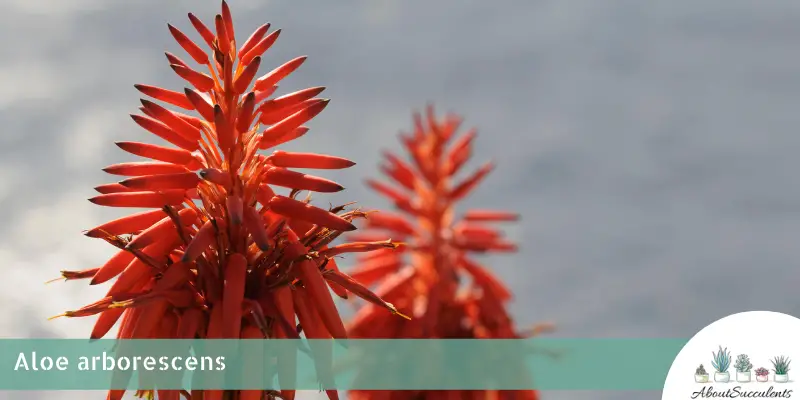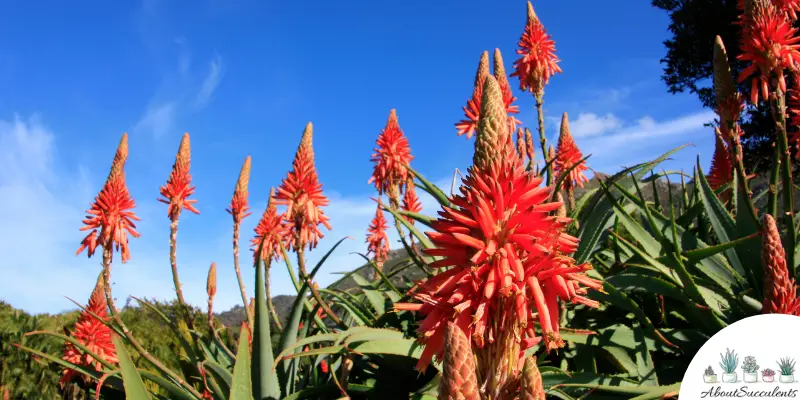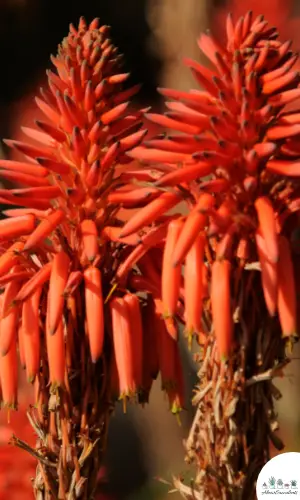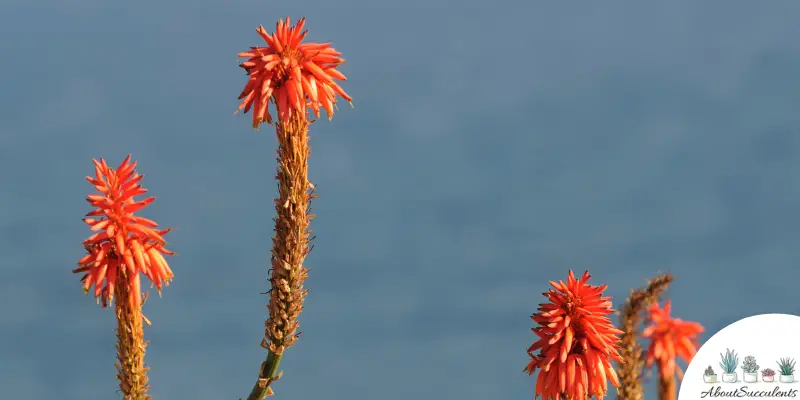
Aloe arborescens is an elegant succulent plant but has an imposing presence because of its size and the sprawling nature of its leaves. In the wintertime, the succulent earns its nickname “Torch Aloe” because it blooms cone-shaped flowers that are colored flaming red or bright orange.
Torch Aloe has a thick stem from where several branches sprout out of a robust trunk that has a hard, wood-like texture. This is a tall succulent that can reach a maximum height of 9-feet (274.32cm). Its leaves can also sprawl 9-feet wide.
The arrangement of its stems and branches in relation to the trunk gives Aloe arborescens the look of a candelabra. No surprise that another alias for this intimidating succulent is Candelabra Aloe.
The leaves have sharp edges and spikes along their edges. For this reason, Torch Aloe is used by landscape gardeners as a natural fence in their design. While hummingbirds and sunbirds are attracted to Aloe arborescens, deers are repelled by its sharp, spiky leaves.
Aloe arborescens is native to South Africa and is a member of the Asphodelaceae family. Because the succulent often grows along the rocky edges of a cliff or “Krantz” in Afrikaans, it has a third nickname – Krantz Aloe.
General Information
Also known as: Torch Aloe, Candelabra Aloe, and Krantz Aloe
Plant Family: Asphodelaceae
Origin: South Africa
Height: 9-feet (274.32cm)
Exposure: Partial to full sunlight for up to 6 hours every day
Water Needs: Drought-tolerant; follow the Soak and Dry method for watering
Soil Type: Sandy or gravelly soil; add 50% perlite, pumice, coarse sand, and lava rock for better drainage.
Soil pH: 5.0 to 6.5
How to Grow and Care for Aloe Arborescens

Aloe vera is grown for its medicinal properties. The leaves of aloe contain a gel-like substance that has been researched and studied by scientists to have the ability to treat skin infections, burns, and cure acne to name a few of its reported medicinal benefits.
Succulent growers say that Aloe arborescens has better health and stronger medicinal benefits than Aloe vera.
Thus, horticulturists love Aloe arborescens because it can provide immediate first-aid, and acts as a natural fence versus deer while making an outdoor garden stylish and distinguished.
Given all of these benefits, you might be surprised to learn that Torch Aloe is easy to grow and care for.
Sunlight
Aloe arborescens can be grown indoors or outdoors. What’s important is that it receives up to 6 hours of partial or full sunlight on a daily basis. If the plant doesn’t get regular rays, the leaves will etiolate or stretch out, wither and eventually die.
Look for a location in your outdoor garden where the required amount of sunlight is guaranteed. Just make sure that it’s morning and not afternoon sunlight or the leaves will get sunburned.
If your area goes through months where the temperature drops below 20° F (-6.7° C), it would be best to plant Torch Aloe in a container that can be moved indoors because this succulent cannot handle the cold.
As an indoor plant, Candelabra Aloe should find a place where it can get partial rays of sunlight for 4 to 6 hours every day. Use Candelabra as an accent plant in a corner of your house that has a window that brings in sunlight.
If this isn’t possible, buy a Grow Light and place your succulent under it for up to 6 hours daily.
Watering

In comparison to its need for daily sunlight, the opposite is true when it comes to watering Aloe arborescens.
Only water the soil when it has completely dried out. Frequent watering will keep the soil moist long enough for it to become a breeding ground for bacteria and fungi.
The roots of the succulent will also rupture and rot away leaving the plant exposed to bacterial and fungal infection.
Follow the “Soak and Dry” method for watering Torch Aloe. Insert a stick an inch into the soil. If the stick feels dry to the touch after you pull it out, the soil is ready to get a thorough soaking.
In the summertime, you might be watering the plant every seven to 10 days. When the cold months hit, the soil will retain moisture longer. You might only water the soil once a month at the most.
Lastly, water from the bottom. This means never watering the plant but only watering the soil.
Pot and Soil
Aloe arborescens looks fantastic in a decorative container and will definitely initiate conversations among your guests.
But more importantly, is the pot made of materials that support aeration? The best pot for succulent plants is one that’s made of unglazed ceramic or terracotta. These materials not only support proper soil aeration but allows fast drainage by getting excess moisture to evaporate quickly along the side of the pot.
Choose a pot that’s slightly larger than the base of Krantz Aloe to keep the roots from getting entangled as the plant matures. The last item on the “best pot for Aloe arborescens” checklist is a drain hole.
The drain hole lets excess water run out. This tells you that the soil has had enough water and at the same time, the drain hole will prevent moisture retention.
Aloe arborescens grows well in sandy or gravelly soil. A branded commercial succulent soil mix will do just fine. Add 50% gritty materials such as perlite, pumice, coarse sand, or lava rocks to speed up drainage.
How to Propagate Aloe Arborescens

In addition to the rock and succulent gardens, do you want to add Aloe arborescens to your planned Mediterranean garden?
If so, the good news is that you can propagate Torch Aloe and there are 3 methods to choose from: Stem/Branch cuttings, offsets, and seeds.
Stem/Branch Cuttings Method
Step 1: Cut a small piece of a stem or a branch using a sterilized and sharpened knife.
Step 2: Give the cuttings 2 to 4 days to grow hard calluses.
Step 3: Place the callused cuttings on top of sandy soil. Water it lightly.
Step 4: Place the pot near a window that gets up to 6 hours of partial sunlight.
Step 5: Cut back on the watering once the roots have formed. Switch to the Soak and Dry method.
Offsets Method
Step 1: Gently pull out the offsets or pups. Use a sterilized and sharpened knife to cut around the pups so you can pull them out successfully with the roots intact.
Step 2: Allow the offsets to harden and grow calluses over a period of 2 to 4 days.
Step 3: Plant the offsets in well-draining succulent soil. Spray the soil with water to keep it moist.
Step 4: If the roots have taken hold in the soil, use the Soak and Dry method for watering the plant.
Seeds Method
Step 1: Plant the seeds in well-draining soil. Choose warmer weather temperatures for planting the seeds to have a better chance of germination.
Step 2: Lightly water the soil and place it under a Grow Light. You can also use a Seed Mat to initiate the germination process.
Frequently Asked Questions
Is Aloe Arborescens Toxic to Cats and Dogs?
Aloe appears in the list of plants that are toxic to cats and dogs found on the website of the American Society for the Prevention of Cruelty to Animals (ASPCA).
If you decide to grow Aloe arborescens as a houseplant, put it in an area that isn’t accessible to your pet.
Why Is My Aloe Arborescens Dying?
Aloe arborescens is a no-fuss succulent plant. But showing it love by giving it too much water will kill it. While neglect is good when it comes to watering, it isn’t if you don’t watch out for pests invading the leaves and draining them of nutritious sap.
Overwatering
Overwatering leads to root rot and you know that this has taken place if you notice the leaves looking mushy and having yellowish-brown spots on them.
These are sure signs of an infection taking place and you should remove these sections right away with a sterilized and sharpened knife. Once the infected sections have been removed, uproot the plant and cut off the roots that have rotted away.
Prepare a new pot with fresh potting soil. Once the plant has dried out, repot it in its new home but hold off watering for 2 to 3 days to give Candelabra Aloe time to get used to the environment.
Pest Infestation
Mealybugs and aphids are the natural enemies of Krantz Aloe. They hide within the leaves and help themselves to sap while secreting waxy substances that could infect your succulent plant.
You can remove these waxy substances by wiping the leaves with a fungicide or a cotton ball soaked in 70% isopropyl alcohol. Get diluted neem oil and spray Krantz Aloe to keep pests away.
Yes. Aloe Arborescens produces cone-shaped flowers that might appear in orange or flaming red colors in the winter.
Last Updated on June 9, 2022 by Sofia Lara